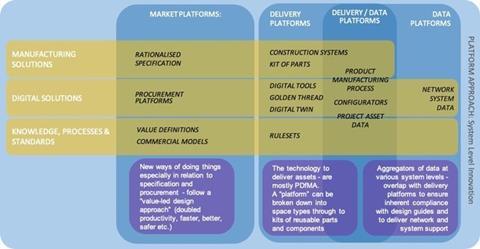We are on a journey that will result in a sector far better than the world can currently imagine, says Sam Stacey
Buckminster Fuller, one of the great architectural visionaries of the 20th century, said ‚ÄúYou never change things by fighting the existing reality. To change something, build a new model that makes the existing model obsolete.‚ÄĚ The Transforming Construction programme was established to build a new model for the construction industry and support the sector on its transformative journey. We are two and a half years into that journey and that new model is taking shape.

The new model is best described as the platform approach. We need only look to the skies above us to see the truly transformative potential of standardised, repeatable platform systems. Pioneering sectors like aerospace have, for many years, applied the ‚Äėkit of parts‚Äô approach to designing and building the thousands of airliners which traverse the globe. In doing so, they have vastly increased the benefits, from productivity and efficiency to greater market willingness to invest in new solutions.
The success of the Transforming Construction programme and the Construction Playbook will depend on the capability of the supply chain
The new model for construction involves three types of platform: market, delivery and data. Market platforms underpin the approach, and include value-based procurement tools and rationalised specifications. Delivery platforms include the rule-sets for the kit of parts, plus the digital assurance of those parts, i.e. their ‚Äėdigital twins‚Äô and ‚Äėgolden threads‚Äô of information. Data platforms cover the manufacturing processes and the system configurators.
The Transforming Construction programme is developing each of these platform types and the component parts are being piloted to prove their effectiveness.

The Transforming Construction programme underwrites the government’s policy drivers: net zero, productivity and levelling-up the economy. To achieve net zero carbon emissions, the is creating an internet of things platform to control energy capture, storage and usage within a building. It is also producing the rules for multi-building energy systems, linking up generation, storage and distribution across a community. To optimise value, more than 120 organisations, led by the , have been involved in the development of a suite of tools and processes that will embed value-based decision making throughout the investment lifecycle. The value platform uses the four capitals model: natural, social, human and manufactured, applied by using a . By providing jobs in factories not tied to the location of construction sites, delivery platforms will support levelling-up.
A key driver of uptake is the government‚Äôs , published at the end of 2020. The playbook mandates the adoption of these platform approaches in the commissioning of schools, hospitals and infrastructure ‚Äď a pipeline of work worth over ¬£30bn a year. This volume of demand will drive investment in skills and equipment, while delivering money-saving economies of scale. Further drivers of change include a new RIBA Plan of Works, due later this year, and the Future Homes Standard, due in 2023. As the existing model becomes obsolete the private sector will adopt the new one. Already we are seeing uptake by major players such as Landsec with their project in south London, and Barratt Homes as part of the project.
The success of the Transforming Construction programme and the Construction Playbook will depend on the capability of the supply chain. The hundreds of organisations already directly involved in the programme are developing the skills that enable them to operate according to the new model. Longer term the industry will need a strategic body to drive further improvements and the training material to implement them. The Construction Innovation Hub and Active ļ√…ęŌ»…ķTV Centre would form the natural basis for such a body.
Perhaps most important of all, I see this model producing buildings and places of beauty and cultural value. There is another Buckminster Fuller quote that I like: ‚ÄúWhen I am working on a problem, I never think about beauty but when I have finished, if the solution is not beautiful, I know it is wrong.‚ÄĚ Platforms will allow us to hone our solutions to an unprecedented degree, and free up our architects and engineers to focus on adapting projects to the precise needs of users and location, rather than designing yet another type of bathroom. Already companies like Huf Haus and Urban Splash have demonstrated the premium cultural value that can be achieved at the building and community level with this approach.
I predict that the journey we are on will result in a construction industry that is better than the world can currently imagine. It will be an industry that wastes no time, energy or materials in delivering beautiful, sustainable and high-quality buildings. In contrast to the current transactional arrangements, business relationships will become increasingly long term and collaborative. Procurement decisions will be driven not by cheapness, but by value to clients and building users. In the new ecosystem we will readily harness the latest manufacturing techniques to assemble precision components in factory environments and new technology, such as sensor-based control systems, will enable ease of building operation. Construction, offering secure and satisfying jobs, will attract the new recruits that we so badly need.
We will have made the existing industry model obsolete.
Sam Stacey, challenge director ‚Äď Transforming Construction, UKRI



























No comments yet